We have only three weeks of school left after this week. One of those weeks will be finals week, therefore, we have two weeks of instruction time left. It really just boggles my mind that it goes by so fast. There is still so much to do. It seems as though no matter how much time there is, we can never get everything done within a school year. I have worked so hard every year to revise and refine my curriculum, but no matter what I do there is just not enough time.
It's frustrating to know that there is no amount of hard work or long hours that will accomplish all that the state has said is required. I could cut out some crucial topics, but that would leave huge gaps in their knowledge. I could step up my pacing and just blaze through topics, but the kids wouldnt learn anything.
Sometimes it is frustrating to know that no matter how good/great/amazing of a teacher I am, I'll never be good enough to get through all of the content. It's frustrating that even though I'm doing everything right and doing all of the things that great teachers do and working hard to make sure my students succeed, it is not enough.
Next year, I will refine the curriculum of my class even more and I will get through even more of the content, but in the attempt to cover the content that means that other important things get pushed to the side. At some point, there will be a realization that our society asks for too much in a 7 hour day/180 day school year.
I think that Public school advocate Jamie Vollmer states it well on his
website...

America’s public schools can be traced back to the year 1640. The Massachusetts Puritans established schools to:
- Teach basic reading, writing, and arithmetic skills, and
- Cultivate values that serve a democratic society (some history and civics implied).
The creators of these first schools assumed that families and churches bore the major responsibility for raising a child. The responsibility of the school was limited and focused for 260 years.
At the beginning of the 20th century, society began to assign additional responsibilities to the schools. Politicians, business leaders, and policy makers began to see the schools as a logical site for the assimilation of newly arrived immigrants and the social engineering of the first generation of the “Industrial Age”. The trend of increasing the responsibilities of the public schools began then and has accelerated ever since.
- From 1900 to 1910, we added
- nutrition
- immunization, and
- health to the list of school responsibilities.
- From 1920 to 1940, we added
- vocational education
- the practical arts
- business education
- speech and drama
- half day kindergarten
- Phys. Ed. including organized athletics, and
- school lunch programs (We take this for granted today. It was, however, a significant step to shift to the schools the job of feeding America's children 1/3 of their daily meals.)
- In the 1950's, we added
- safety education
- driver's education
- expanded music and art education
- foreign language requirements are strengthened, and
- sex education introduced (topics escalate through 1990's)
- In the 1960's, we added
- Advanced Placement programs
- consumer education
- career education
- peace education
- leisure education, and
- recreation education
- In the 1970's, the breakup of the American family accelerated, and we added
- special education (mandated by federal government)
- Title IX programs (greatly expanded athletic program for girls)
- drug and alcohol abuse education
- Head Start
- parent education
- behavior adjustment classes
- character education
- environmental education, and
- school breakfast programs appear (Now, some schools are feeding America's children 2/3 of their daily meals. Sadly, these are the only decent meals some children receive.)
- In the 1980's the flood gates open, and we add
- keyboarding and computer education
- global education
- ethnic education
- multicultural/non-sexist education
- English-as-a-second-language, and bilingual education
- early childhood education
- Jump Start, Early Start, Even Start, and Prime Start
- full day kindergarten
- pre-school programs for children at risk
- afer school programs for children of working parents
- alternative education in all its forms
- stranger/danger education
- anti-smoking education
- sexual abuse prevention education
- health and psychological services are expanded, and
- child abuse monitoring becomes a legal requirement for all teachers
- In the 1990's we added
- HIV/ AIDS education
- death education
- expanded computer and Internet education
- inclusion
- Tech Prep and School to work programs
- gang education (in urban centers)
- bus safety education
- bicycle safety education, and
- gun safety education
And in most states we have not added a single minute to the school calendar in five decades!
All of the items added to the list have merit, and all have their ardent supporters. They cannot, however, all be assigned to the schools.
The people of each community must come together to answer two essential questions: What do they want their children to know and be able to do when they graduate, and how can the entire community be organized to ensure that all children reach the stated goals.
The bottom line: schools cannot do it all.
Schools cannot raise America's children.
What is the solution to this? I'm not sure, but I do know that at some point somethings gotta give. I also know that I LOVE EVERY MINUTE OF IT. I absolutely love being a teacher and making a difference in the lives of kids. I also know that there are amazing things happening in schools and that far too often people focus on the few negatives rather than the multiple positives. Basically, if a person is looking for the bad things, then that person will find them. I also know that I'm doing my best to help make school a better place for my students and, for now, that's all I can do.
 The tripod is out on the river. It's been there for awhile. There isnt this much snow left, this picture is from two years ago. I finally bought my Ice Classic tickets. Break up is nearing.
The tripod is out on the river. It's been there for awhile. There isnt this much snow left, this picture is from two years ago. I finally bought my Ice Classic tickets. Break up is nearing.

































